I am a 12-percenter. At age 58, I have a 12.4% risk of dying before I turn 68.
How do I know this?
It’s straightforward crude mortality data, the absolute risk of death for a white man in the U.S. at age 58. The relative risk of death for a black man aged 58 is 50% higher, meaning that, not adjusting for any risk factors, he has an 18% absolute risk of death before age 68. That’s almost a one in five chance of dying at what most people today regard as a relatively young age.
Women fare much better. Black women at age 58 have an absolute risk of death within ten years of 11.4%. For white women, it is 8% or 30% lower than black women.
Middle-Age Is an Opportunity, Not a Sentence
Mortality risk in the fifth and sixth decades of life is the snowball rolling down the hill. The risk of death doubles every decade starting in the fourth (your thirties) when it is only 1.6% for a white male, which seems quite benign. The numbers get really scary when you look at mortality risk in the seventh decade, 14.3% for a white man and 21% for a black man. It only gets worse from there, until you realize these are unadjusted or crude death rates that don’t take into account risk factors and health habits.
Far too many Americans regard middle-age as the start of a slow-motion death sentence, when, in fact, it is their best opportunity to not only prolong their lives but boost quality of life, as well. As a strength training advocate for over forty years, I believe this to my core. I started lifting in 1975, long before there was a shred of data in the U.S.-based English-language peer-reviewed scientific or clinical literature that individual strength had either health or athletic value. In fact, I believed in primacy of strength (i.e. it being more important than cardio alone or flexibility) before StrongFirst was even a twinkle in Pavel’s eyes.
Data demonstrating the power of physical strength and fitness in middle-age are compelling; there are impacts on overall mortality, brain health, cancer risk for both men and women, and heart health (and, it is generally true that what’s good for the heart is good for everything). Striving for a high level of fitness while that exertion is still possible is the single most important thing any adult over age fifty can do for him- or herself. Inaction will not only weigh on the individual (no pun intended), but on all of us, because nearly all mortality is preceded by illness that sucks away quality of life and economic productivity and at least some avoidable medical care spending.
So why aren’t middle-aged Americans answering this call? Because the conventional fitness industry and the government and its private sector water carriers, such as the American Heart Association and the American College of Sports Medicine have failed them. Being intentional about building and sustaining the highest level of fitness you can is a really hard path to walk, and thirty minutes daily of “physical activity” is not the answer to any meaningful health question.
Your Tool in the Fight Against Mortality
This is why the kettlebell—this odd, 200-year-old Russian creation—is so important to impacting the habits of middle-aged adults. I know now from vivid personal experience that no other tool is so adaptable to the needs of the user and so accessible to nearly anyone who is willing to learn to use it. Adaptability and accessibility are two critical but rarely discussed elements of America’s fitness deficit. Without them, the notion of long-term sustainability and manipulation of critical risk factors while passing through middle age is just a pipe dream.
When I began Shotokan karate with my son nearly three years ago (he was nine, I was 56), I learned quickly that a lifetime of bench-squat-pulldown-curl-crunch had not prepared me for the turns, kicks, blocks, strikes, complex stances, and feints of the most technical sport I’d ever tried. A friend kindly suggested I look into Pavel and kettlebells, and thus began a metamorphosis that is still unfolding. I have gone from a consummate kettlebell klutz to an older athlete whose exercise repertoire expands by the month.
Most striking, however, has been how one tool has helped maintain or improve all three major fitness components: strength, power, and endurance. Even though I no longer run or cycle, my resting heart rate remains at around 60, and my blood pressure is healthy (118/70), as are my waist:height ratio (<0.5), blood sugar (90), blood lipids (HDL = 65, ratio of 3.5:1), and weight (156 on a 5’5” frame which, ironically, gives me an “overweight” BMI that my wife’s employer’s wellness vendor says, laughably, is dangerously overweight). The impact on my karate has been transformative because get-ups and swings (and now snatches) challenged and improved my mobility in ways I could never have predicted. This is all from a consistent regimen of three self-taught training sessions weekly, of about 45 minutes each.
The Risk Factors You Must Manage
Long-term health and the prevention of premature mortality is all about risk factor management. Since you cannot change your age or gender (okay, technically you can, but that’s not really the point, is it?), you must manage the risk factors that are modifiable. These are maintaining a healthy blood sugar, blood lipids, blood pressure, and body weight, which are all possible only if you eat a diet of reasonable quality, exercise regularly (notice I did not say be “physically active”), and don’t smoke. How much of a difference in death risk does this make? A lot.
Three different large scale studies (here, here, and here) in completely different populations produced nearly the same results: if you keep these risk factors healthy, the relative reduction in mortality is 70 to 80% compared to people who have none. So, stated another way: if the absolute (unadjusted) risk of death is 20%, people in whom these risk factors are all healthy may have a death risk of around 4%. The clock will beat you eventually, but why have it run out sooner than is absolutely necessary?
And, we have not even tapped into the conversation about the impact that exercise—regular, vigorous, challenging exercise—can have on novel risk factors that we don’t routinely measure, such endothelial health, neurological function, clotting, and mental health. Or the fact that the medical establishment—unless it can co-opt and medicalize exercise, thus making it something from which it can profit—ignores exercise as salubrious and refuses to acknowledge that contrary to popular medical myth there is no known mortality ceiling on the benefits of cardiorespiratory fitness.
Your Best Bet in This Battle
And the best part? You can manage your risk factors and improve your journey through middle age with this cannonball with a handle. In the privacy of your home. In your hotel room. In your office. With friends. On your own. Inside. Outside. In the morning. In the evening. On holidays. Smart, demanding, safe kettlebell training is the end of the perpetual excuse machine that hamstrings fitness in America. It is also the tool that opens doors to all kinds of possibilities, such as living longer by living better.
Kettlebell aficionados are fond of the cannonball-with-a-handle moniker. I prefer to think of it as the world’s most effective, if awkward, life preserver.
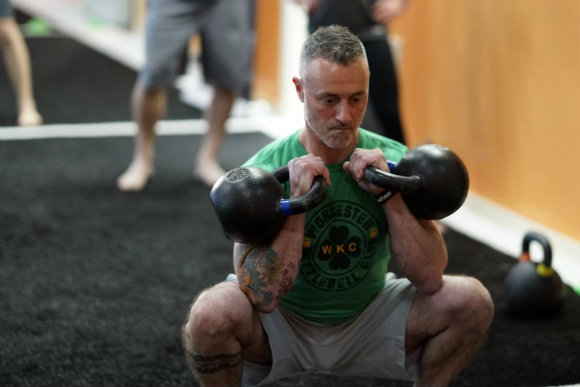
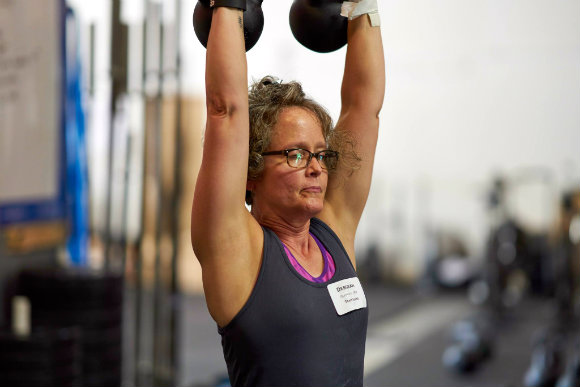
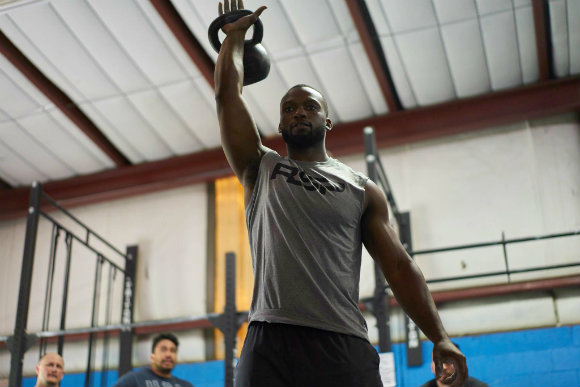
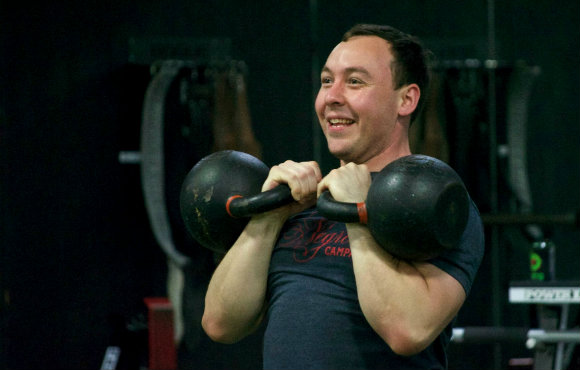
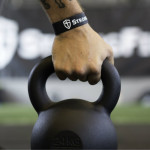
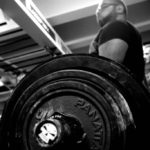
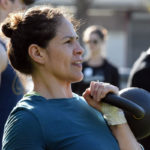
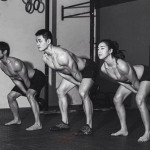



Great article, I call the kettlebell the Fountain of Youth. I hit 55 this year but can still do things most teenagers struggle to do, all because of the black ball with a handle.
Great article Vic. But you are a kid! I’m 76 and have been lifting weights since 1955. I have been using the wonderfully evil looking kettlebells since 2002 and they are the mainstay of my training these days. Lots of snatches with 24K, standing presses, etc. I did competitive powerlifting for 25 years…retiring at age 72 (just got bored with competing and putting on power meets). These days I do a combination of interval sprints and kettlebell work. I feel like I’m 35, and much enjoy being a positive example for the huge benefits of strength training (and overall fitness) can mean for people in their 6th + decade of life.
Richard, that is awesome!
Very neat article Vik. After reading it it really inspired me to stick with the cannonball and stop bouncing around kbell, bbell & bw routines, like a n00b does. The idea of picking up an implement and start cranking out reps without being overly scientific in setting up a jig (Aka bbell) has a whole simplicity about it in my mind. Being on the right side of mid-forties (or is that the wrong side!) I’m a decade behind you. Diet is reasonably good but sitting all day and generally being sedentary outside of the office over the last 7 years is taking its toll on the heart health, bp in particular. Keen to read other posts of yours. Cheers
Thanks, Mark. I am with on the simplicity issue. It not only makes it easy to build a sustainable program, it gives your fewer excuses not to train. There’s nothing to wear out or break except you, and the more you train, the less likely you are to do either. Stick with it!
Wow what a great article, I am a couple decades behind you (36) but I started training at 30 to get healthy and now I train to improve my quality of life and help extend it. your article really hit the nail on the head.
Thanks, Jeff. I bet we’ll communicate again when you are 56 and I am 78, going on 79. I may be using lighter bells then than I am now, but I will still be roaring ahead. I bet you will be too. No limits on improving quality of life!
Vik,
Yours is one of my favorite articles I’ve read on the StrongFirst blog. That’s great information for anyone. I started lifting weights in 1968, the summer before I entered high school. I wanted to discourage the bullies and attract the girls. It for sure worked on the bullies.
I’ve lifted weights ever since then, started CrossFit in my mid-50’s (I’m 61 now), and have been using my 7 kettlebells at home. My waist:height ratio is also well under 0.50, and last week at my physical, blood pressure was 110/70 and heart rate was 56. Even though I’ve seen my strength decline over the last couple of years due to changes related to age, I feel way better than I did even 20 years ago.
Walt, thanks for your very nice comment. You and I and others like us should start some kind of club…old guys and gals who knew lifting was good for life before anyone else did. There might be a lot of us, but we’d be strong and that’s what would really matter.
Great article Vik, your advice is appropriate and appreciated.
And best of luck for your SFG 1.
Yusuf Khan.
Love this piece,55,do 3 crossfit sessions in my sons gym in Ireland,check it out “crossfit INFECTED” I’m in better shape now than in my 20s.looking forward to growing older and stronger.love what the team at INFECTED are giving the youth.
I too am in healthcare,Rn,see so many young people just aging ,slowing up,dying slowly instead of living actively.we need to teach the youth,who model themselves on us,we need to spend time playing with them,teaching them to love and live activity,life is not lived looking at a screen
? From ireland
I am exactly the same age and discovered kettlebells in 2014. I also have a home made programming, but I’m seeing the same results. I taught my stepson,who has Down’s syndrome, how to do get ups. He does one each side every night after supper. Even that little bit has changed his body composition. I’m afraid to teach him swings, but we have a short work out with bear crawls, sledge hammer, medicine ball, goblet squats and farmers walks that has dropped his resting heart rate to 50. Needless to say, but I’ll say it anyway. What Pavel has started will make us all live longer and better. I find it amusing when I see young girls checking out my stepson who has Down’s syndrome.
Norman, thanks for your note, which is compelling. My mother was a teacher’s aide in a classroom of special needs kids, like your stepson, for over 20 years. She would be very heartened by what you have taught your son. God bless and continued progress to both of you.
Excellent article but would you be willing to share your “three self-taught training sessions weekly, of about 45 minutes each”?
I am going to guess:
Get Up
Swing
Snatch
Hi RJ, happy to do so. I’ll share the now, instead of all the mistakes and false starts that went into getting to where I am. I typically start with Get Ups…4 empty (and really slow and smooth) to warm up, then 2 with 20kg, 2 with 24 kg, and finally 2 with 28kg. Then, I typically circulate between combinations of swings, cleans, presses, front squats, goblet squats, and these days a lot of snatches. I have built a spreadsheet with all the KB exercises I’ve taught myself so far (I am much better at some than others), and I usually select 6 to 8 for a training session. The spreadsheet is designed to calculate total poundage, reps, etc., so I can track my progress in a very detailed way. These days I end my training with one more Get Up, but one in which I do a press at each posture. I use the 20kg most of the time, but if I am really tired, I go down to the 16kg. This is actually helping me teach myself to do a bent press, which has mystified me.
How fast I work and how heavy I go depend on the goal for the day and sometimes just how I feel. I am almost always done within 45 minutes, and I virtually never go over an hour. On the flip side, I can build a really hard, effective session to be done in just 15 to 20 minutes if the day is packed. Like I said in the piece…adaptability is one of the great elements of KB training.
I am happy to communicate more about this if you’d like. You can email me at Samurai3907@Gmail.com.
Thanks for reading and for your kind words. I am glad you liked it. Vik.
Vik,
Great article! This resonates deeply with me, and it is very well written. Thank you. I found kettlebells at age 46, and I earned my SFG1 on (literally), my 50th birthday, and it was a blast to have celebrated my 50th in that fashion. I’m pretty sure KBs rescued me from a life of aches, pains, and depression. The best thing of all is, that the movements don’t get stale – I still truly enjoy doing the ballistics and grinds, and practicing the skills, and love how strong and healthy they make me feel, and I don’t have to kill myself trying to ‘get a workout in’. This is what I try to pass on to anyone and everyone who will listen to me. : )
Ballistics and grinds…love those two words. In the strength training manual I wrote for the dojo where my son and I train, I divided the KB work into those two categories. People unfamiliar with KB training (nearly everyone) looked me like I was a crazy man. We are two months into the program and the adults participating no longer think I’m crazy; they are deeply into it, as are a couple of the older teens. The younger kids are still wondering about it all (except for mine, he trains with me), but they’ll get there. Thanks for reading and for your praise. Vik.
Vik,
Great article! This resonates deeply with me, and it is very well written. Thank you. I found kettlebells at age 46, and I earned my SFG1 on (literally), my 50th birthday, and it was a blast to have celebrated my 50th in that fashion. I’m pretty sure KBs rescued me from a life of aches, pains, and depression. The best thing of all is, that the movements don’t get stale – I still truly enjoy doing the ballistics and grinds, and practicing the skills, and love how strong and healthy they make me feel, and I don’t have to kill myself trying to ‘get a workout in’. This is what I try to pass on to anyone and everyone who will listen to me. : )
Vik,
Nicely done. I’m a 50 year-old physician and recently achieved my SFG1 certification and I can’t agree more with what you wrote so eloquently. Similar to you, I also have young children and there are a lot of sports I like to play with my kids and kettlebells keeps me on the field, and not on the sideline. And, in a society that keeps getting larger and more sedentary, our kids model our behaviors and I would rather them model strength training and fitness than being a couch potato.
Again, very nicely done. Wishing you the best at your upcoming cert.
“Get busy living, or get busy dying.”
John
Thanks, John. You are the second physician to respond to positively to the piece. I got a very nice email from a doc who is approaching age 70 and still training daily.
I will keep you (and the other folks in this comment thread) in mind as inspiration on my cert weekend.
Thanks for your support.
Vik.
What a great article…as a fellow health care professional (RN), I see clients everyday in the hospital setting who cannot move well, who are frail at a relatively young age, who have fallen because they merely lost their balance and cannot right themselves, and have suffered the subsequent hip fracture….and I could go on and on. And not just the elderly, even young people with back pain, or who cannot squat to pick something off the floor!
As someone soon approaching my late 40’s, and who works out from home, and has exercised primarily with kettlebells the last 10 years, I have to say that I am so thankful for the real world strength, mobility and flexibility they give me. and I am beyond humbled and greatful for the RKC/SFG insructors that I have been fortunate to utilize on occasion. Currently I have been doing Simple and Sinister since June 1, am about to soon test if I can go up in swing weight, and am doing 3 of my 5 sets of getups with the 16kg at the moment (met the time goal a few times for 12kg getups fairly quickly and my strength has always outpaced my conditioning over my whole exercising life) and my shoulders couldn’t be more flexible and sturdy and happy. Have done major amounts of yardwork for weeks without barely breaking a sweat or feeling sore the next day. And can keep up with my demanding job. I look forward to growing older strongly and gracefully and am in better shape now than in my 20’s and 30’s!
That’s the key, TB…we keep getting better as we get older. Most of the folks around us are just getting older.
Keep leading the way, and thanks for your support.
Great article, Vik!